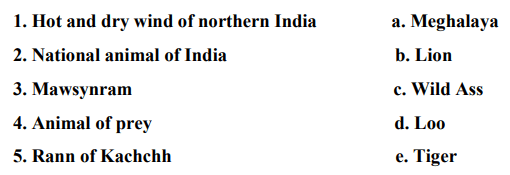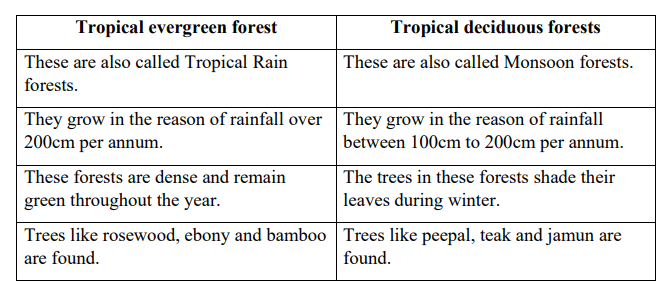A. Tick the correct option.
1. Which one of the following places in India experience very high temperature?
Answer: Jaisalmer
2. Which one of the following places receive the highest annual rainfall in the world?
Answer: Mawsynram
3. In which areas are the rhinoceros found?
Answer: Swamps of Assam
4. Identify the type of forests found in Kerala.
Answer: Tropical Evergreen Forests
5. In which type of forests are kikar and babul trees found?
Answer: The Thorny Forests
B. Fill in the blanks.
1. The North-west India experiences ___________ climate.
2. Mumbai enjoys ___________ climate.
3. Tropical cyclones strike the ___________ coasts of India.
4. Most of the rainfall in India is caused by ___________.
5. ___________ is the important tree of Mangrove forests.
Answer: (1) extreme (2) moderate (3) eastern (4) south-west monsoon winds (5) Sundri
C. Match the following:

Answer: (1) d, (2) e, (3) a, (4) b, (5) c.
D. Answer the following questions in brief.
1. State the significance of monsoon for the people of India.
Answer: People of India eagerly wait for the arrival of the monsoon rains to get relief from the oppressive of heat of the Indian weather. It also affects crops.
2. Why do the northern parts of India experience extreme climate?
Answer: Northern parts of India experience extreme climate because it is away from the moderating influence of the sea. Thus, the summers are extremely hot and winters are extremely cold.
3. Which type of natural vegetation is found in the Andaman and Nicobar Islands?
Answer: Tropical Evergreen forests are found in the Andaman and Nicobar Islands.
4. Where are one-horned rhinoceros found in India?
Answer: One-horned rhinoceros are found in the marshes of Assam and West Bengal.
5. Give one important reason for a large variety of wildlife found in India.
Answer: A large variety of wildlife found in India because there are different type of natural vegetation and climatic condition.
E. Answer the following questions.
1. Distinguish between tropical evergreen forest and tropical deciduous forests.
Answer: The difference between tropical evergreen and tropical deciduous forests are:

2. Why do we need to conserve our natural vegetation?
Answer: We need to conserve our natural vegetation because it gives atmospheric oxygen to the environment that we breathe. We get different types of natural resources from them. So, it is necessary to conserve our natural vegetation.
3. Highlight two main features of the retreating monsoon.
Answer: The two main features of the retreating monsoon are:
- The monsoon winds start retreating from the northern plains when temperature begins to fall in the months of October and November.
- The weather in North India becomes clear but high humidity makes it very oppressive and sultry.
4. Why does the natural vegetation in the Himalayan mountains change with altitude?
Answer: In the Himalayan mountains the vegetation changes according to the altitude because the temperature and rainfall decreases with height.
5. What efforts has been made in India to preserve our rich wildlife?
Answer: A number of wildlife sanctuaries and national parks have been set up all over India in order to preserve our rich wildlife. ‘Project Tiger’ a nationwide campaign to protect Tiger was launched in 1973.